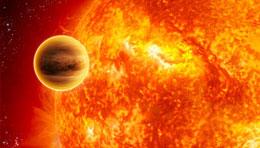Nature News | Ken Croswell | 2011 Aug 09
Giant alien planet pulls surface of its star up and down.
Astronomers believe they have spotted a distant star's surface rising and falling in response to the gravity of an orbiting planet, just as the Moon tugs Earth's seas up and down.
It was known that the planet, which orbits the star WASP 18 in the constellation Phoenix, would induce huge tides in its star because the planet is ten times the mass of Jupiter, and lies so close to WASP 18 that it orbits it in less than a day.
The planet lies at a distance of 100 parsecs from the Sun, and was reported in 2009. It first betrayed its presence by passing between us and its own star, causing the star to dim. Astronomers then confirmed the planet's existence by detecting Doppler shifts in the light from WASP 18 as the planet's gravity pulled the star towards and away from Earth1.
But the planet's orbit posed a puzzle. In planets that lie very close to their stars, the force of the tides is so great that it changes the orbit from an ellipse — as seen in the planets of the Solar System — to a circle. "For orbits that are close in, the tides will attempt to take the energy out of the noncircular part of the orbit and dump it into the star or the planet as heat," explains Phil Arras, an astronomer at the University of Virginia in Charlottesville.
Yet the Doppler data suggested that the planet orbiting WASP 18 had a slightly elliptical orbit, similar to that of Neptune.
Gravity shift
Arras and his colleagues think that they have now explained the anomaly2. The planet's orbit is circular after all, they say. The Doppler shifts in starlight that make the orbit seem elliptical are, in fact, caused by the star's surface rising and falling with the pull of its planet's tides.
When the star's surface rises toward us, its spectrum shifts slightly towards the blue, and when it falls away from us, it shifts slightly towards the red. The findings have been submitted to the Monthly Notices of the Royal Astronomical Society and posted on the arXiv server2.
"With it being such an extreme system, we knew that it was going to be a good test of tidal theory," says David Anderson, an astronomer at Keele University in Staffordshire, UK, who helped to find the planet but is not involved with the latest study. Anderson says his "gut feeling" is that the new explanation for his team's data is probably correct.
Of all known planets, the one around WASP 18 raises the greatest tides in its star. Arras' team calculates that the Doppler shift shows the star's surface rising and falling at roughly 30 metres per second, which current instruments can easily detect.
Last year, astronomers reported that planetary tides were causing the star HAT-P-7 to bulge, making its brightness change depending on which side of the star was being observed3. But if Arras' team is right, WASP 18 is the first time that astronomers have actually observed a star's surface rising and falling in response to planetary tides.
Anderson and Arras would like additional observations to confirm the tidal idea. Arras says that a detailed re-analysis of the data may reveal a signature that can distinguish tidal movements from elliptical orbits.
- An orbital period of 0.94 days for the hot-Jupiter planet WASP-18b - C Hellier et al
- Nature 460 1098 (27 Aug 2009) DOI: 10.1038/nature08245
- The Radial Velocity Signature of Tides Raised in Stars Hosting Exoplanets - P Arras et al
- arXiv.org > astro-ph > arXiv:1107.6005 > 29 Jul 2011
- The Discovery of Ellipsoidal Variations in the Kepler Light Curve of HAT-P-7 - WF Welsh et al
- Astrophysical Journal Letters 713(2) L145 (2010 Apr 20) DOI: 10.1088/2041-8205/713/2/L145
arXiv.org > astro-ph > arXiv:1001.0413 > 03 Jan 2010 (v1), 05 Feb 2010 (v2)
- Astrophysical Journal Letters 713(2) L145 (2010 Apr 20) DOI: 10.1088/2041-8205/713/2/L145
